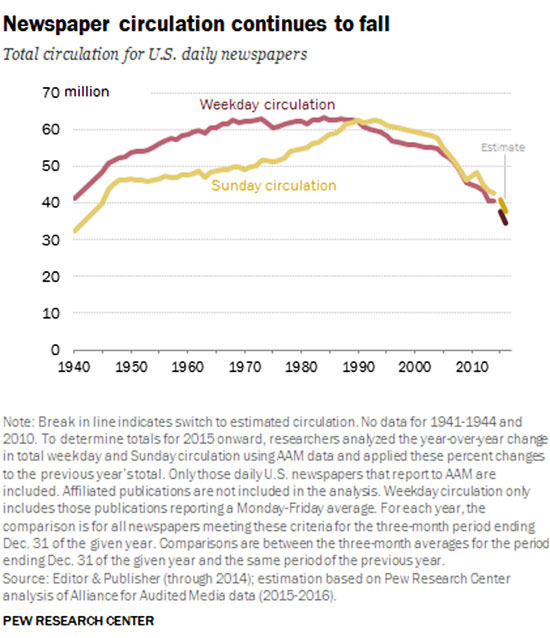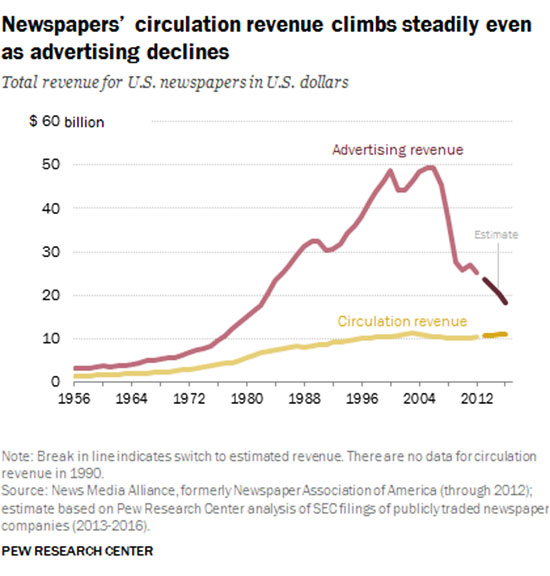|

by Scott S. Bateman
July 21,
2018
from
Medium Website
|
Scott S. Bateman is a journalist and entrepreneur. He
spent 20 years in senior and middle management at two
major media companies.
https://www.PromiseMedia.com
|

Credit: Pixabay
Creative Commons license
The death of
the newspaper industry is a
legend-in-the-making story about managers who oppose change.
It's also a lesson in how
to undermine innovation...
Business schools and business books often cite the
collapse of Eastman Kodak as a leading example of what happens
to companies when their managers refuse to innovate.
Kodak dominated print
photography for decades and fought against the transition to digital
until too late.
"More than 130 years
after a 'not especially gifted' high school dropout, George
Eastman, founded the camera company that dominated photography
for most of the 20th century, Eastman Kodak filed for
bankruptcy protection in the U.S. on Thursday," The Guardian
newspaper said on Jan. 19, 2012.
Part of the company
eventually came out of bankruptcy and focuses today on a much
smaller market:
business imaging.
The Kodak failure is
minor compared to the state of the newspaper industry. Print
newspapers are quickly shrinking staffs, budgets and product sizes
even during a growing economy.
Although some seem to have a future online - the New York Times
is a notable example - the print versions will cease to exist at
some point in the near future.
Their costly newsprint,
printing plants and manual circulation systems are too expensive to
compete with digital publishing that has none of these costs.
Like Kodak, newspapers waited until too late to innovate
aggressively and prepare for the massive changes resulting from the
digital distribution of information.
Newspapers closed or
suffered layoffs at an alarming rate during the
2008 Great Recession and will do so
again during the next recession.
The (Denver) Post has
cut its staff about 70 percent since Alden and its founder
Randall Smith took control in 2011, according to data from the
Denver Newspaper Guild.
CNBC, June 16, 2018
How did an industry with
near monopoly status in local markets get to this point?
They did it in 10 ways
involving slow innovation, no innovation or resistance to it.
1 - They saw
digital as a threat
Digital wasn't just a threat to the print business.
It was a personal threat
to the compensation of executives, senior managers and middle
managers.

Credit: Pew Research Center
Newspapers often use management by objectives in their compensations
models.
Pay raises, bonuses and
commissions depend on achieving targets for advertising sales and
circulation subscriptions. Editors saw the threat as an attack on
their readership.
Newspaper websites pulled
readers and advertisers away from the print product. Even worse,
managers received little or no compensation tied to digital
performance.
Innovation requires a willingness to take risks even at the
potential expense of the core business.
It shouldn't come at a
cost to the compensation of managers and employees.
2 - They
jammed a print business model into an online environment
Publishers and circulation managers in particular believed that
newspaper websites should require paid subscriptions in the same way
that most newspapers require them.
From the beginning, they made repeated attempts to make people pay
for access.
Nearly all of them
failed, but they continued to spend money, use valuable time and
energy, and chase away website visitors with more attempts.
Free TV station websites
gained customers as a result.
One exception was the New York Times, which made a
substantial investment in new content for a paid online product that
went far beyond the daily print version.
"Digital-only
subscriptions totaled approximately 2,644,000 at the end of the
fourth quarter of 2017, a net increase of 157,000 subscriptions
compared with the end of the third quarter of 2017 and a 41.8
percent increase compared with the end of the fourth quarter of
2016."
The
New York Times
Publishers didn't
understand that people could now get local news, sports results,
weather forecasts and other information from free websites produced
by TV stations, other businesses and a wide variety of nonprofits,
schools and government agencies.
Innovation thrives in part because of creative thinking and a new
way of looking at a business.
It doesn't thrive with
restrictions from old and sometimes outdated rules.

The cost structure of print newspapers
can't
compete with more efficient digital publishing.
Credit:
Pixabay Creative Commons license
3 - They
didn't understand they lost their monopoly status
Newspapers in recent decades largely had a monopoly status in the
cities and towns where they were located.
As a result, they had
exceptional reach and control over readership and advertising.
During the 1990s, rising national websites offered much of the same
information newspapers had traditionally offered such as TV
programming, stock quotes, national and international news, national
sports news, cartoons, recipes, columnists and movie reviews.
Those sections in
newspapers shrank or even vanished in response.
Even more painfully came the competitors to advertising, especially
the highly lucrative classified ad categories of,
-
employment
(Indeed and Monster)
-
automotive (AutoTrader,
Cars.com and many more)
-
real estate (Zillow
and Realtor.com)
In response, many
newspaper companies tried to protect their employment advertising
business and instead destroyed it by partnering with the now-defunct
Yahoo! HotJobs.
Local innovators learned how to publish their own local news,
weather and sports.
The above mentioned
nonprofits, schools and government agencies built websites that had
much more information than newspapers could offer in print because
of space limitations. No such limitations exist on a website.
Successful innovation is a timely, proactive response to a change in
the business environment.
It requires an open mind
and careful observation of trends in the community and industry.
4 - They
undermined their own innovators
Many entrepreneurs within major newspapers were required to follow
harsh rules that undermined their own profitability.
One newspaper company required its own website operation to pay $1
million a year for the right to publish the newspaper's content. The
same newspaper was making a small fraction of that amount by selling
it to other electronic services such as LexisNexis.
Exorbitant fees prevented profitability, which in turn raised
accusations that newspaper websites weren't financially viable.
The lack of
"profitability" also undercut future growth and critical investments
in content and staff. Internal jealousy and opposition blocks
innovation.
Executive management has
a responsibility to remedy the causes of any opposition.
If necessary, those
remedies include firing or demoting managers who stand in the way of
innovation.
5 - They
either over invested or under invested online

Credit: Pew Research Center
Some newspaper companies did make major investments in online
operations during the early years of web browsing.
But the investments were
so large that the financial losses resulted in massive pullbacks and
staff layoffs.
In their case, they invested too early in online before online
advertising revenue had risen enough. The financial scars made them
reluctant about future large investments.
When the 20018 Great
Recession hit, they could no longer afford big investments at all.
Managers who are given the responsibility for innovating a new
product, service, division or even company need constant vigilance
over the rate and timing of investments.
6 - They got
addicted to 40 percent profit margins
Astonishingly, some newspapers achieved profit margins as high as 40
percent as a result of having a local monopoly.
It was a drug too good to
give up...
As print margins started declining, these same newspapers opposed
online investments in order to protect the print profit. It was a
fixation on short term solutions to smaller problems at the expense
of much bigger problems in the years ahead.
Few print newspapers if any now enjoy 40 percent profit margins.
As a result, low margins
inhibit innovation because of the potential risk of failure and
unacceptable costs.
"The Richmond
Times-Dispatch on Monday laid off 33 full-time employees and
announced a reorganization of the printed newspaper as a result
of declines in print revenue."
The
Times-Dispatch, April 3, 2017
7 - They got
lazy
Google and executives at other
online companies were famously known for working more than 100 hours
a week to build their high-growth companies.
Likewise, those same
companies had lucrative compensation packages for people in middle
management to encourage their own exceptional workload and a
constant focus on innovation.
Anecdotally, I didn't know any newspaper executives who regularly
worked those kind of hours during a lifetime in the industry.
I certainly didn't know
any managers in the lower ranks who worked more than 50–55 hours a
week on a regular basis because they weren't paid to work that way.
Besides, the high profit
margins needed protecting.
No newspaper executive or senior manager will ever admit to being
lazy, which is a harsh and relative term. Some like myself did have
temporary spikes in their hours, especially during budget time.
But it's true that they
simply were outworked by the competition.
"The other piece that
gets overlooked in the Google story is the value of hard work.
When reporters write
about Google, they write about it as if it was inevitable. The
actual experience was more like, 'Could you work 130 hours in a
week'?" said Marissa Mayer, former Yahoo! CEO and one of the
first Google employees.
"The answer is yes, if you're strategic about when you sleep,
when you shower, and how often you go to the bathroom. The nap
rooms at Google were there because it was safer to stay in the
office than walk to your car at 3 a.m.
For my first five
years, I did at least one all-nighter a week, except when I was
on vacation - and the vacations were few and far between."
8 -
Executives paid themselves first
As a fairly successful small business owner after leaving senior
management, I learned the survival of my newspaper consulting
business came first and my personal financial desires came second.
I pocketed the smallest
amount of monthly compensation possible and waited until the end of
every year either to take profit out of the business or reinvest the
profit into it.
Even during the depths of the recession, some newspaper companies
increased their executive compensation despite plunging profits.
They also gave away zero-based stock options that diluted their
stock equity.
(A zero-based option is
the right to buy company stock without having to pay for it, then
sell it on the market at full price.)
In the meantime, many of these executives laid off employees,
stopped salary increases, killed pensions and ended matching
contributions for 401k plans.
Demotivating employees
while increasing executive compensation is not a way to protect the
business or encourage innovation.
9 - They
took on too much debt
Some newspaper owners recognized the severity of the trends and sold
their companies.
Examples include the
Pulitzer family and the Graham family of the Washington Post.
Other owners went in the opposite direction. They bought the media
properties including newspapers and TV stations that went up for
sale before the Great Recession.
Remarkably, they bought
these properties even as their own numbers were declining.
When the Great Recession hit, a combination of their debt payments
and plunging profits made it more difficult than ever to innovate.
Some declared bankruptcy; others will declare it during the next
recession.
Aggressive innovation is possible with strong financials.
Google couldn't afford
the $571 million loss during the first quarter of 2018 in its
Other Bets subsidiary without the company's 22 percent net
profit margin.
10 - They
ignored new online streams of revenue
Newspaper executives think of two critical business metrics for
print:
They provide nearly all
of the revenue that has made newspapers so profitable over decades
and even centuries.
But the same isn't quite true about online publishing because
competition decreases the potential revenue from readers and
advertisers. Some newspaper publishers understood that point.
They tried to diversify
into other revenue streams such as website hosting and design and
even selling the products of competitors such as
Google AdWords.
Many publishers became so captivated by trying to defend plunging
profit margins that they had no time, money or staff to pursue other
streams of revenue with enough success.
Newspapers as we have known them are going through historic changes
that showcase the impact of innovation at a societal level on an
entire industry.
It also showcases what
happens when the industry struggles with its own innovation in
response.
|





